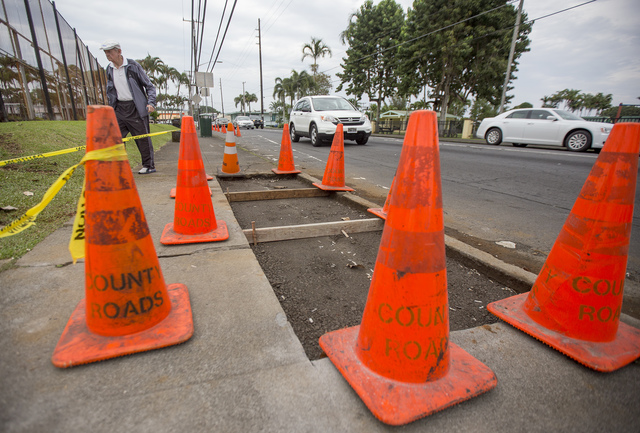Ever dream about one day setting foot on the surface of the Moon, or even Mars? ADVERTISING Ever dream about one day setting foot on the surface of the Moon, or even Mars? East Hawaii residents will soon have the
Ever dream about one day setting foot on the surface of the Moon, or even Mars?
East Hawaii residents will soon have the opportunity to get closer to living out that dream when the Pacific International Space Center for Exploration Systems unveils its “Lunar Sidewalk” project in Hilo.
The sidewalk, fronting the tennis courts mauka of Lincoln Park on Kinoole Street, will feature three different slabs made from experimental volcanic basalt materials that could one day be used to build structures and pavement on other worlds.
As NASA moves forward with its goals of long-term explorations of the Moon, Mars and asteroids, setting up infrastructure at the exploration sites to cater to autonomous vehicles will be a problem that needs to be solved early on, explained Christian Anderson, PISCES operations manager.
“Upon landing on the surface, there is an amount of dust that gets blown up, and assuming they’re landing near an area where they previously dropped assets, that dust creates a sandblasting effect, causing serious damage to whatever is there,” he said. “You need something to stabilize the surface you’re going to be landing on.”
Secondly, he said, as humans make their way to these new worlds, they will need structures within which to live, “both for shelter from radiation, which is considerably higher because there is no atmosphere on Mars or the Moon, and also in terms of protection from micro-meteors.”
Sending vast amounts of concrete into space isn’t economical, so scientists are working to find ways to create alternative forms of cement using offworld materials, Anderson said.
Luckily, the dirt found on the Moon and Mars, known as regolith, is extremely similar to Hawaii’s volcanic basalt.
Scientists have developed three different methods for binding the locally produced basalt, and this afternoon at 2 p.m., the county will pour three slabs of sidewalk along Kinoole Street in an effort to test the materials and find which ones are the most durable.
“The materials have been tested in labs, but NASA hasn’t had the opportunity to have long-duration testing in extreme environments,” Anderson said.
In addition to benefiting space exploration, the technologies also could benefit Hawaii directly, according to PISCES.
“Using local basalt instead of mainland cement to produce concrete would help reduce the economic and environmental costs the state currently pays to import and process more than 300,000 metric tons of cement per year,” PISCES said in a written statement.
One method of using basalt rebar to bind cement is used in countries in Asia and Eastern Europe, Anderson added.
“You take basalt fibers, similar to Pele’s Hair which we get out of the volcanoes, and compress it into rebar form and use epoxy to hold it together,” he said. “It outperforms steel rebar and is a quarter of the weight and it doesn’t corrode, which is huge.”
The Lunar Sidewalk project is the result of a collaboration between NASA, the Hawaii County Department of Research and Development, the University of Hawaii at Manoa and Kodiak FRP Rebar.
Email Colin M. Stewart at cstewart@hawaiitribune-herald.com.



